Pros
-
Packed with features
-
Good vacuuming performance and powerful suction
-
Excellent value
Cons
-
Mopping performance is only fine
-
Buggy software
About the Lefant M3
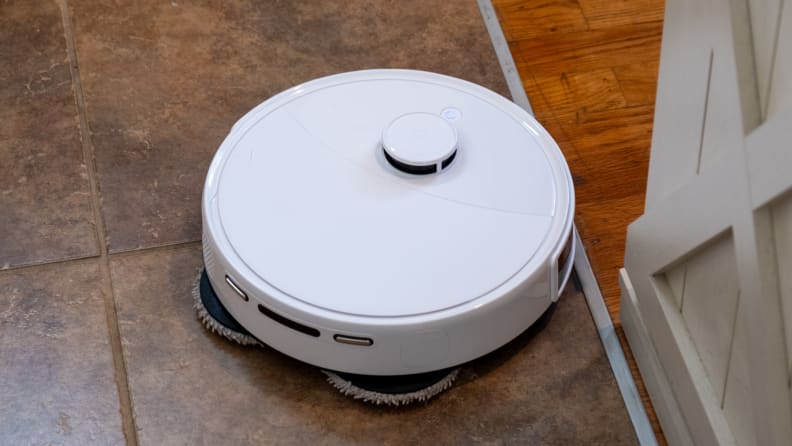
The combination of solid vacuuming performance, hot-water mopping, and more is nice to see in the Lefant M3 at this price point.
- Dock dimensions: 14.57 x 15.16 x 14.05 inches (L x W x H)
- Suction power: Up to 12,000Pa.
- Mopping system: Dual rotating mops (200 RPM) with auto-lifting for carpets.
- Navigation: 360° dToF laser mapping.
- Battery Life: Up to 220 minutes of runtime.
- Smart home integration: Google Assistant, Amazon Alexa.
The Lefant M3 comes in white and has a retail price of $799.99 on Amazon and $1,500 on Lefant’s site, though it's routinely heavily discounted—at the time of writing, it is available on Amazon for just $294.99, making it one of the most feature-rich options available at this price point.
What we like
It offers a full set of cleaning features in a decently compact build
The Lefant M3 manages to pack vacuuming, mopping, and self-cleaning into a system that doesn't dominate your living space. The docking station itself has a relatively compact footprint, despite housing water tanks, a dust bag system, and a mop-cleaning apparatus. Many competing models with similar feature sets require significantly more floor space for their base stations, making the M3 a better fit for apartments or homes with limited space.
The build quality isn’t bad either. The white plastic construction can feel slightly cheap, but not overly so, and it’ll look perfectly fine in most homes.
The vacuum can operate in vacuum-only mode with four suction levels, or vacuum and mop simultaneously with customizable mop cleaning intervals measured in minutes. The package includes a cleaning solution for the mopping function, which is a nice touch that many competitors skip, forcing you to buy it separately.
Vacuuming performance is solid
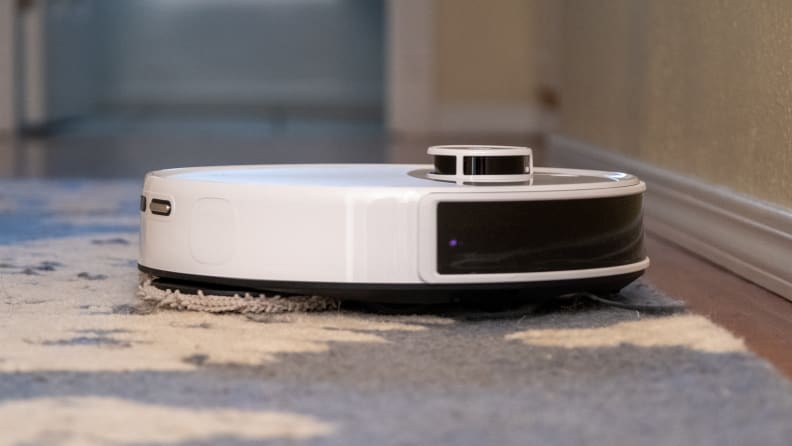
The M3 delivers solid vacuuming performance, effectively handling most household debris. The M3 has an automatic carpet detection feature too, and it worked quite well, increasing suction when transitioning from hard floors to rugs.
The M3 delivers solid vacuuming performance, effectively handling most household debris. In testing, it didn't achieve perfection on the first pass—smaller debris like sesame seeds could occasionally be flung out of the vacuum's path by the main brush and left behind. This isn't unique to the M3, though—even premium models struggle with lightweight debris that can scatter.
A second pass reliably collected the remaining particles, and the strong suction power handled debris that did make it underneath the vacuum without issue. The M3 has an automatic carpet detection feature too, and it worked quite well, increasing suction when transitioning from hard floors to rugs.
The vacuum also has a V-shaped anti-tangle brush, and while it won't avoid tangles altogether, it did seem to work decently well.
The suction power on offer by the Lefant M3 is perhaps the best thing about its vacuuming performance. Others at this price point, like the Roborock Qrevo QV 35A, usually hover around the 8,000Pa suction power, while the M3 hits 12,000Pa. To be clear, raw power doesn't always translate to better cleaning, but it sure does help.
Automated daily maintenance is a bonus
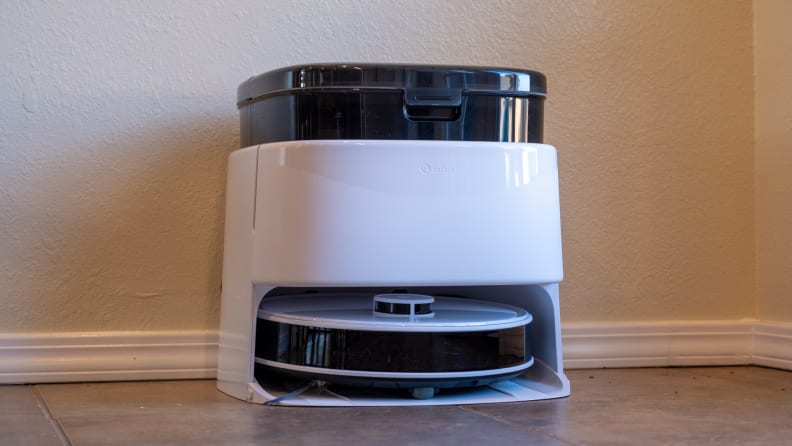
The Lefant M3 manages to pack vacuuming, mopping, and self-cleaning into a system that doesn't dominate your living space. The docking station itself has a relatively compact footprint, despite housing water tanks, a dust bag system, and a mop-cleaning apparatus.
Robot vacuums that handle daily maintenance are commonplace these days, especially in the more expensive and tech-forward models, but it's still nice to see, especially at this price point.
Beyond occasionally refilling the clean water tank and emptying the dirty water tank, there isn’t much maintenance required. The dust bag is relatively large and should hold at least a month or two of debris for most households, while the water tanks are large enough that you won’t have to fill or empty them more than every few weeks, under normal usage. The automated mop washing and drying cycle means you're not dealing with smelly, dirty mop pads — a common complaint with cheaper mopping robots that require manual pad washing.
Again, there are others that have these features at this price, including some from Roborock.
You are getting a great value for the feature set
The Lefant M3 offers a range of helpful features that are often reserved for more expensive options. High suction power is one such feature, as is hot-water mop washing and an automatic cleaning solution dispenser. Some models at this price point have one or two of these features, but it's still rare to see all of them together under $700.
One of Lefant’s main competitors at this price, the Roborock Qrevo QV 35A, has detergent dispensing, but its suction power is lower, and it doesn't have hot-water mop washing.
What we don't like
The mopping system is only fine
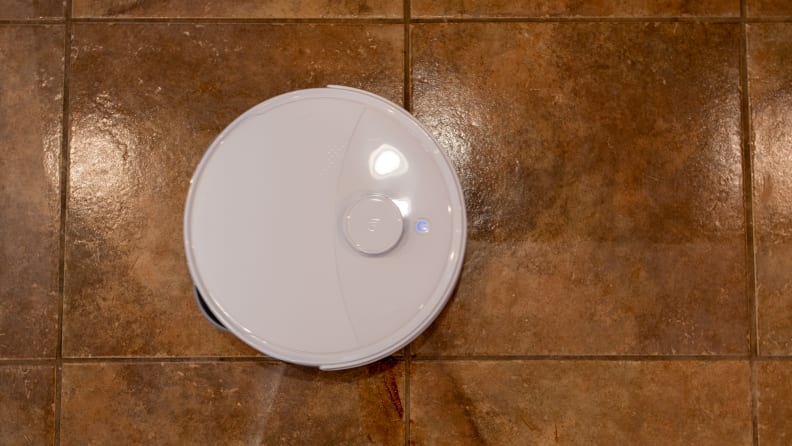
The M3's spinning mops clean decently but would have been notably improved with roller technology.
While the spinning mop system works fine, it highlights one area where the M3's budget price shows through. Many modern high-end robotic vacuums have transitioned to roller mops that can apply significantly more pressure to floors, resulting in better cleaning of stuck-on messes. The M3's spinning mops clean decently but would have been notably improved with roller technology. It’s not surprising to see spinning mop pads at this price point, but still, hopefully, roller mops will become more common at lower prices soon.
There are other limitations to the mopping performance. There's no option to vacuum first, then mop in a second pass—a feature that prevents dust and dirt from mixing with the mopping water and creating muddy streaks. The vacuum also lacks a mop-only mode that would raise the brush roll. During testing with barbecue sauce on the floor, I found the brush sweeping through the sticky mess before the mops could clean it up. Despite using the included cleaning solution, the M3 left behind sticky residue that required manual cleanup. Higher-end models with more powerful mopping systems and better cleaning patterns would have handled this test more effectively.
Software is buggy and complicated
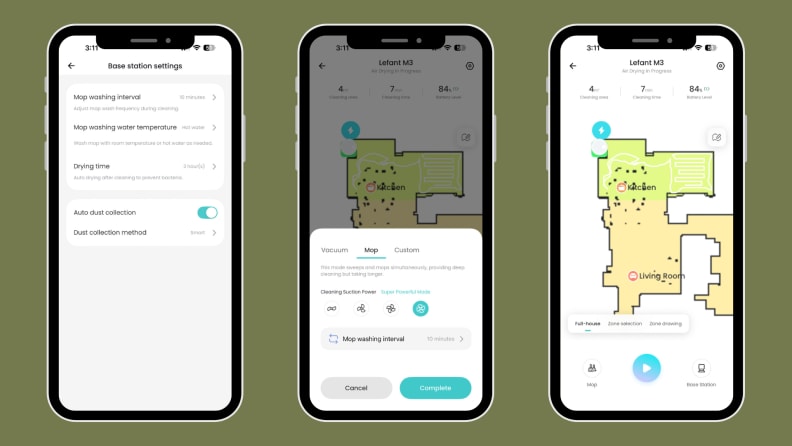
Most users will want to map their space first before setting the robot loose to clean, but I had to dig through settings to find a way to create a quick map.
The setup process proved more complicated than necessary, with several important steps missing from both the printed instructions and the app's guidance. The app made it frustratingly difficult to create a map without triggering a full cleaning cycle. Most users will want to map their space first before setting the robot loose to clean, but I had to dig through settings to find a way to create a quick map. This basic functionality should be included in the initial setup process.
Map creation itself worked reasonably well, but required manual editing afterward. The vacuum set my admittedly somewhat combined kitchen and living room as a single "Room 1" while lumping everything else — including a hallway, office, and bathroom — into "Room 2." While editing the map was straightforward, and most robot vacuums don't nail room detection on the first try, the M3's interpretation seemed particularly confused about what constitutes a separate room.
The app itself had numerous grammatical errors throughout its interface, as well. While not a functional problem, in an era of AI-powered proofreading tools, this lack of polish feels unnecessarily sloppy. Beyond language issues, the app's design makes certain functions harder to access than they need to be. Switching between cleaning modes isn't immediately obvious, though it is easy once you learn the interface.
The vacuum's firmware had occasional bugs during testing as well. One session generated a warning that no dust bag was installed, even though one clearly was—the error resolved itself after a few seconds without any intervention. Another time, the vacuum couldn't figure out how to reach a zone I'd drawn on the map, despite having just cleaned that exact area minutes before. The zone was directly in front of the docking station, yet the vacuum attempted to navigate through a maze of dining table and chair legs instead of taking the direct path.
While none of these issues proved to be dealbreakers and the software usually sorted itself out, they represent the kind of compromises that come with the lower price point.
Warranty
The Lefant M3 comes with a standard one-year warranty that covers manufacturer's defects. In other words, if you accidentally damage it, the warranty won't cover repair or replacement.
What owners are saying about the Lefant M3
Reddit: On the /RobotVacuums subreddit, users had mixed feelings. One user wrote that the vacuum was "Absolutely awesome for the money," while others noted bugginess around the mopping system.
Amazon: The M3 has generally positive reviews on Amazon, with an average of 4/5 stars. Users noted solid vacuuming performance, but one said, "As for mopping, it is not much more than a light damp mopping and so don’t expect much there."
As a whole, users find the M3 to be solid value, but not necessarily great at everything—and in some cases, buggy.
Should you buy the Lefant M3 Robotic Vacuum?
Maybe, if you want a feature-rich robovac at a low price
The combination of solid vacuuming performance, hot-water mopping, and more is nice to see in the Lefant M3 (available at Amazon) at this price point. However, many will settle for not having hot-water mop washing in return for a more complete, less buggy software experience. Roborock's Qrevo QV 35A comes at a similar price, and may not have as many features as the Lefant, but it does have a better mapping system with more in-app options.
That said, if you don't really care about those extra software features, don't mind a bit of bugginess, and are willing to buy from a less established brand, then the Lefant M3 is still worth considering. It handles daily cleaning relatively well, and if you can find it for under $300, it’s an absolute steal.
Meet the tester
Christian de Looper is a consumer tech journalist with over a decade of experience. De Looper has covered all areas of the consumer tech industry, from smartphones to smart homes — and has attended all of the major trade shows, including CES.
De Looper has always been interested in consumer technology, but his love for gadgets and electronics blossomed into a full-blown passion when he started writing about it while completing his degree in audio production.
Since then, he has written for many of the top tech publications, including Digital Trends, Tom’s Guide, TechRadar, and many more. He loves getting his hands on all of the latest gadgets, but when he’s not reviewing tech, he can be found hanging out with his family or producing music.
Checking our work.
Our team is here to help you buy the best stuff and love what you own. Our writers, editors, and experts obsess over the products we cover to make sure you're confident and satisfied. Have a different opinion about something we recommend? Email us and we'll compare notes.
Shoot us an email




